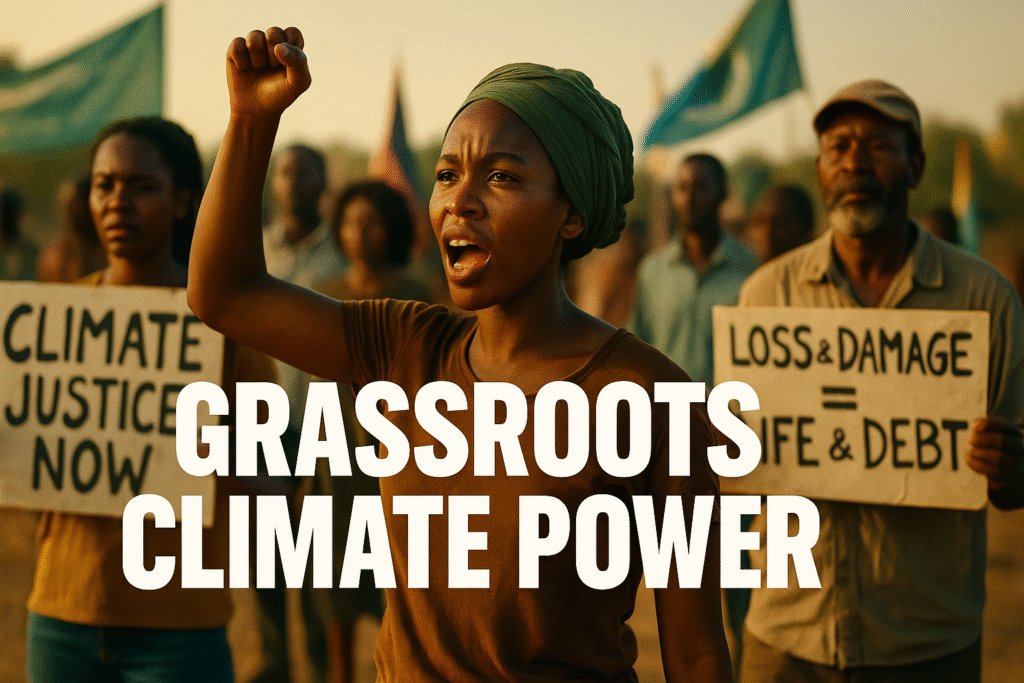

African Grassroots Demand Climate Justice Ahead of COP30
By Darius Spearman (africanelements)
Support African Elements at patreon.com/africanelements and hear recent news in a single playlist. Additionally, you can gain early access to ad-free video content.
The History Behind The Headlines
Introduction: African Climate Justice Movements and COP30 Demands
African grassroots coalitions are mobilizing in the run‑up to COP30 to demand climate justice, reparations for historical extraction, and urgent financing for adaptation and loss & damage. In addition to public demonstrations, they are issuing policy demands, coordinating continent‑wide positions, and centering voices of frontline communities. While the headlines describe marches and press statements, the deeper story grows from histories of extraction, colonial trade patterns, and ongoing multinational investment practices that shape vulnerability today.
Key Terms Explained: Infographic
This report breaks the story into clear parts: what activists are demanding now, the historical roots of their claims, a close look at the financial and statistical context, and why this movement matters to African and diaspora communities. Each point includes sources that document both actions and analysis, allowing readers to trace claims and figures directly.
Detailed Analysis of the Current News Story: Grassroots Calls for Justice
Grassroots groups across Africa have been increasingly visible in their demands. They call for an end to extractive exploitation, highlight cases of environmental racism, and demand direct, grant‑based financing for adaptation and losses already suffered. In addition to public marches and symbolic actions, these coalitions push for meaningful participation in international negotiations and challenge corporate narratives that frame fossil projects as “development.” (AP News: AP News)
Coalitions such as PACJA and networks connected to the Climate Justice Alliance focus on centering frontline communities. They demand that climate finance be accessible to local organizations, rather than being filtered through large intermediaries that often favor market solutions. They emphasize that finance tied to loans or corporate investment often deepens debt burdens and allows multinational companies to capture profits while communities absorb harm. (PACJA: PACJA background; Laudato Si’ Movement: Laudato Si’ Movement)
Historical Context: Extraction, Colonial Legacies, and Ecological Debt
To understand current demands, it is necessary to situate them in longer histories. European colonialism reconfigured African economies around the extraction of minerals, oil, and cash crops, while political structures were shaped to favor an export-oriented approach. After independence, multinational corporations often continued the same patterns under new guises. Over decades, environmental damage, land dispossession, and unequal trade compounded vulnerability to climate impacts.
Activists frame these problems as ecological debt owed by high‑emitting nations and companies that have profited from centuries of extraction. Consequently, calls for reparative finance and non‑debted support are rooted in this historical argument. That framing is increasingly visible at regional gatherings and faith‑based statements, which demand recognition and restitution rather than technocratic fixes alone. (Laudato Si’ Movement: Laudato Si’ Movement)
Detailed Analysis: Financial Context, Emissions, and the Loss & Damage Gap
Activists point to data that underscores their claims. Africa contributes a small share of global greenhouse gas emissions—typically cited as around 3–4 percent—yet it bears disproportionate climate impacts, including droughts, flooding, and severe storms. Therefore, activists demand that wealthy nations and polluting industries accept responsibilities beyond current promises. (AP News: AP News)
The Loss & Damage Fund established at COP28 marks a historic step, but initial pledges totaled hundreds of millions—far below many estimates of needs, which range into the tens and hundreds of billions annually for a comprehensive response. Activists use this mismatch to call for rapid scaling, predictable flows, and direct access for communities. Analyses and multilateral press releases document the Fund’s operationalization and the ongoing debate about governance and adequacy. (World Bank: World Bank; Heinrich Böll Stiftung: Heinrich Böll Stiftung)
In addition, adaptation finance—the money required for infrastructure, resilient agriculture, and disaster preparedness—remains far short of requirements. Civil society demands that new finance be grant‑based and not channeled primarily through private investment vehicles that create profit opportunities for corporations rather than meet community needs. (Financial Times: Financial Times)
Historical Context: Resistance, Organization, and the Role of Frontline Leadership
African climate activism has grown through decades of local resistance to extractive projects and environmental harm. Community organizing around land rights, pollution, and coastal protection has turned into broader continental coordination. Over time, networks have learned to translate local grievances into policy demands at international fora by centering frontline voices and building alliances across nations and regions.
Timeline: Milestones in African Climate Justice (Simple Timeline)
These networks also borrow tactics and language from global climate justice movements—using terms such as “frontline communities,” “ecological debt,” and “just transition.” They emphasize the necessity of keeping fossil fuels in the ground to secure a livable future for African communities, while demanding resources to adapt to the current damage. (Climate Justice Alliance: Climate Justice Alliance)
Conclusion: Why African Grassroots Climate Justice Demands Matter Today
These movements matter because they shift the frame from technocratic carbon accounting to justice, history, and power. They center communities who experience the brunt of climate crises and insist that responsibility align with historical emissions and profits. As COP30 approaches, their influence changes negotiation dynamics by pressing for reparative finance, direct access to funds, and accountability for corporations that profit from African resources.
For the African diaspora, this movement holds emotional and material significance. Families and communities in the diaspora have kin ties to affected regions. Furthermore, equitable climate policies can reduce forced migration, economic precarity, and cultural loss. Therefore, an Afro‑Diasporic perspective supports both immediate humanitarian relief and long‑term structural change in international economic relations. (AP News: AP News; World Bank: World Bank)
ABOUT THE AUTHOR
Darius Spearman has been a professor of Black Studies at San Diego City College since 2007. He is the author of several books, including Between The Color Lines: A History of African Americans on the California Frontier Through 1890. You can visit Darius online at africanelements.org.
